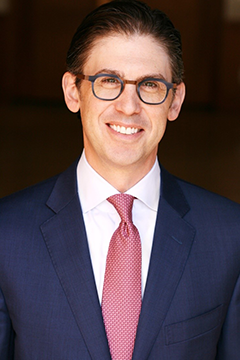The Hebrew term for synagogue is beit k'neset. It means "house of assembly" and thus approximates the Greek word 'synagoge' which also means "assembly." For centuries, the synagogue functioned primarily as the ancient world's idea of a "JCC," a place for Jews to assemble. These institutions dotted the Jewish landscape even while the Second Temple-shrine of our ancient worship-stood. The synagogue of antiquity might have struck us as surprisingly "secular" in orientation. Originally, people may not have come to the synagogue primarily to pray or study. They conducted local business in the synagogue, promoting the general welfare of the Jewish community. Accelerated by the destruction of the Temple in 70 CE, synagogues evolved to absorb many of the ritual and religious observances of an emergent Rabbinic Judaism. Over time the beit k'neset also became a beit t'filah, a "house of worship," and often a beit midrash, a "house of study," too.
The archetype of the synagogue, the Tabernacle that constitutes the focal point of the wandering wilderness community, completes construction in Parashat P'kudei. "In the first month of the second year, on the first of the month, the Tabernacle was set up" (Exodus 40:17). The text credits Moses with erecting the completed structure and arranging all of its fixtures, beginning with its planks and posts, and concluding with the screen covering the outermost gate. "When Moses had finished the work, the cloud covered the Tent of Meeting, and the Presence of the Eternal filled the Tabernacle" (Exodus 40:33-34). The Tabernacle, spiritual antecedent of the synagogue, is complete. The text signals God's satisfaction with the work when God's Presence enters the structure. Over the Tabernacle a cloud rested by day, and fire would appear in it by night, as a constant, visible reminder of God's nearness and as a guiding presence for the Israelites' journeys (Exodus 40:36-38).
That human beings have successfully brought God into their midst through the construction of a sacred sanctuary marks a dramatic shift in ancient Near Eastern mythology. The Mesopotamian Epic of Creation is typical in its depiction of the gods creating their own dwelling place on earth, here to be named Babylon:
The Anunnaki [Babylonian deities] began shoveling. For a whole year they made bricks for it.When the second year arrived,. . . they had built a high ziggurat for the Apsu [other deities]. (Tablet VI, from Myths from Mesopotamia, trans. Stephanie Dalley [New York: Oxford University Press, 1989], p. 262)
The Torah, in contrast, imagines human beings teaming up to fashion earthly materials (precious woods, metals, fabrics) into a place where God's Presence will abide. The inversion is poetic and brings God's work of creation full circle. In the first chapter of Genesis, God creates a home for human beings to inhabit. In the last chapter of Exodus, human beings, Israelites charged with a holy purpose, create a home for God to inhabit.
This image invites us to return to our original question: "What is the purpose of a synagogue?" Ultimately the answer is, "To make God's Presence noticeable."
Sometimes the architecture itself can achieve this. Certain synagogues through purely physical means can elicit spiritual inspiration. Some sanctuaries through their sheer magnitude can inspire a feeling of awe; others achieve this effect through opulent materials, beautiful art, and carefully designed lighting and sound. Other spaces strive for intimacy or warmth. Natural light and windows that open to the world provide a different kind of inspiration than representational art or stained glass. Still other synagogues evoke the glory of Jewish history or images from the Bible and thus may both instruct and inspire. Many people report that a synagogue's architecture helps them feel God's Presence.
However, the synagogue must also make God's Presence noticeable through other means. A famous midrash proposes that it was only through the meritorious behavior of humanity, culminating in the deeds of Moses, that God--long since alienated from the human realm by our transgressions--could return to earth and dwell among us (P'sikta D'Rav Kahana, Piska 1:1).
God migrates to and from the world of human affairs in accordance with our ethical attentiveness or inattentiveness. Behavior matters more than a building. Indeed, the fulfillment of mitzvot on behalf of others, compassionate action for people in pain, and tzedakah for people in need can all make God's Presence more noticeable in the world. And the synagogue is the primary Jewish engine for organizing people into communities of caring.
Study, prayer, ritual observance, community building, tzedakah, concern for the welfare of all Jews and all humanity--these constitute the pillars of a thriving, inspirational synagogue. Every time I see our congregation reach out with a loving embrace, with hot meals and gentle words, to a family walking in the valley of the shadow of death, I see the synagogue making God's Presence noticeable. Every time I see congregants awaken to a new insight during Torah study, I see how the synagogue has helped make God's Presence noticeable. When youths and adults felt inspired a few weeks ago to travel on a local Jewish relief mission to New Orleans, I saw our synagogue making God's Presence noticeable. When we sing our Kabbalat Shabbat service on Friday night and even the people struggling with Hebrew are moved to sing along for L'chah Dodi, I see the synagogue making God noticeable.
Jewish mystical tradition claims that God is everywhere and in all things, if only our vision permits us to see. The shattering daily news makes it too easy to conclude that we live in a godless world. Our parashah endorses the vital role of the synagogue in restoring our faith in a world in which God's Presence abides. The synagogue functions as a spiritual magnifying glass. It helps us to see what has been there all along.
Rabbi Jonathan E. Blake is senior rabbi of Westchester Reform Temple in Scarsdale, New York.
Rabbi Blake so poetically describes the purpose of our present-day synagogue and mentions Moses's critical role in building its prototype, the Tabernacle, in the wilderness. But how was Moses able to accomplish such a prodigious task? Although Moses did not grow up in an Israelite culture, he was able to duplicate the strengths of the patriarchs on his own.
Moses learned his passion for justice from Abraham. Abraham pleaded with God in defense of the innocent of Sodom and Gomorrah (Genesis 18:20-33); Moses defends the innocent Hebrew slaves, killing the Egyptian taskmaster (Exodus 2:11-12). And seeing two Hebrews fighting, he upbraids the wicked one (Exodus 2:13).
With his life at stake Moses flees into the wilderness, as Jacob had fled from Esau (Genesis 28:5, 10). His adventures parallel those of Jacob. As Jacob met his beloved Rachel at a well (Genesis 29:9-11), Moses meets Zipporah (Exodus 2:16-17). Moses works for his father-in-law and becomes, like Jacob (Genesis 29:20, 30), a stranger in a strange land with the strength to endure and prosper as an outsider.
Moses also has a link to Isaac. Isaac and Moses each have only one wife, one love; and both, though in different ways, resign themselves to a higher cause.
Only after Moses has internalized the life experiences of the patriarchs does God hear the groaning of the Children of Israel and reenter Jewish history, remembering the covenant with Abraham, Isaac, and Jacob (Exodus 3:6-7). Moses is the agent through which the covenant is carried forward. To lead God's people from Egypt to Sinai and back to the Promised Land-to transform a tribe of slaves into a free people possessing a covenant with God and building a sanctuary to remind them of that covenant-required a leader with the moral stance of Abraham, the self-sacrificing resignation of Isaac, and the wily heroism of Jacob.
But for me the greatness of Moses lies beyond his embodiment of the best of our patriarchs-even beyond his faith and patience and the willingness of the people to believe in him. His greatness lies in his ability to believe in the people. If a leader does not believe in the potential greatness of those he or she is leading, then true greatness will never be realized. Moses believed in the people Israel; therein lay his prodigious greatness.
Rabbi Helene Ferris is rabbi emerita of Temple Israel of Northern Westchester in Croton-on-Hudson, New York.
"P’kudei, Exodus 38:21-40:38
The Torah: A Modern Commentary, pp. 680-690; Revised Edition, pp. 627-636;
The Torah: A Women's Commentary, pp. 545-566"
Explore Jewish Life and Get Inspired
Subscribe for Emails


